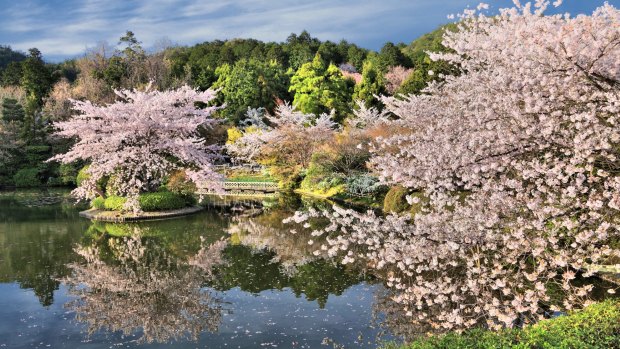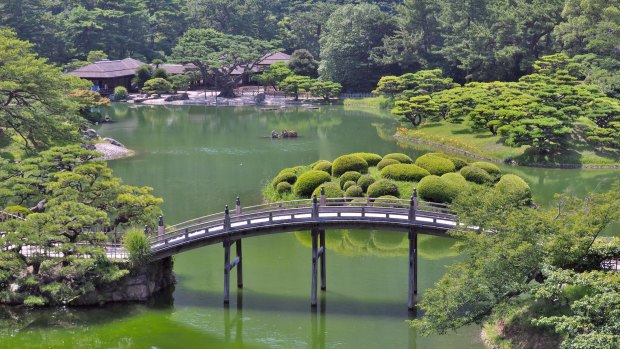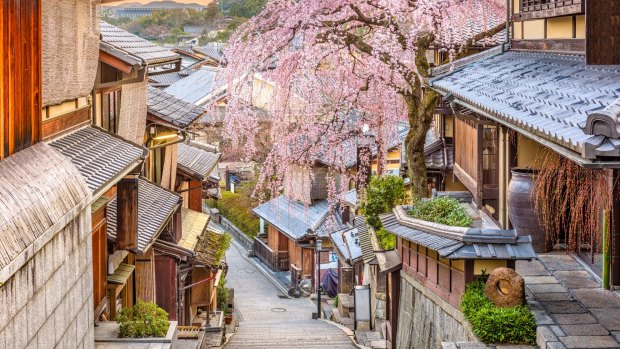This was published 4 years ago
Cruise Japan during cherry blossom season: The best places to see them
By Sarah Maguire

'A magic pink carpet starts to unfurl before us': Cherry blossom season in Japan.Credit: iStock
On the way to the Samurai castle town of Hagi, spring blossoms are flying at the bus window like snow. It's cold and windy outside and for the first time on a 12-day small-ship cruise - from Osaka to Kanazawa with stops at eight ports on three islands and one in South Korea - it feels like we are deep in the Japanese countryside.
Lime-green rice fields, groves of bamboo bending in the wind, and traditional curvy-roofed farmers' homes flick past on the two-hour drive from Shimonoseki port, as do generous pink and white splashes of cherry trees in bloom.
That's what we've come to see, on this Botanica World Discoveries Cherry Blossoms, Culture and Sights of Japan cruise, although as the name of the tour indicates, there is plenty more on the itinerary than opportunities to see trees.

A view from a hill in Ritsurin Garden in Takamatsu city, Kagawa Prefecture.Credit: iStock
Hagi, a coastal town in the western Yamaguchi prefecture of Honshu Island, is a case in point. On this day alone, our cohort of 70 mostly Australian cruisers will experience a broad and busy sampler of what Japan has to offer: castle ruins and temples, local cuisine and craft, samurai history and culture; and at numerous points along the way, expert guides will draw our attention towards beautiful things botanic.
We need no assistance to spot the 600 blooming cherry trees in moated Shizuki Park, site of the ruins of Hagi Castle from which the feudal lords of the Mori samurai clan ruled for nearly 300 years, beginning about the time craftsmen kidnapped from Korea were establishing a new type of pottery known as Hagi-yaki.
We eat our traditional Japanese lunch off several pastel-coloured pieces of it at the seaside Senshuraku restaurant. Among the 10 dishes is sushi, sashimi, grilled beef and steamed seabream, and a salad with blow fish skin - the famously potentially-lethal delicacy is caught wild in the waters off Hagi.

Kyoto in the historic Higashiyama Ward.Credit: iStock
There are many opportunities to buy our own glossy piece of Hagi-yaki while strolling the preserved streetscapes of the World Heritage-listed town. Its layout is largely unchanged since feudal times, including the Samurai quarter where the revolution that ended the Shogun's rule in the 1860s began.
In the neighbouring mercantile and craft district we file, wearing our socks, through the 500-year-old Kikuya residence, past displays of the artefacts and accoutrements, including Hagi-yaki, of a wealthy merchant family that for centuries ran the town on behalf of the ruling Moris.
In the garden, there's no wandering: the grass is off limits, so we slowly hop in a line, almost conga-style, from one wide-set paving stone to the next as Julie Prent, one of our two botanical guides, points out crepe myrtles and camellias, little beech trees and leaning pines, and an old lichen-covered cherry tree.
By this point in our trip, Day 8, we're well used to being amid the bridges, water courses, plants, rocks and teahouses of magnificent Japanese gardens, from Koraku-en in Okayama, one of Japan's Great Three gardens, to the 350-year-old Ritsurin Koen on Shikoku Island. We've learned a fair whack, too. Simon Rickard, the other of our expert guides, has been to Japan 20 or so times and his knowledge and high regard of the art of Japanese gardens is evident from Day One, when we get off to a rocky start in more ways than one.
My first meal in Japan is on a coach. It's a bento box that's lovely to look at with its pops of colour from pickled vegetables and minuscule prawns amid a profusion of curious ingredients. It has taken us a while to hook up with our lunch, due to some confusion over the pick-up point. Many among us are bleary eyed after arriving in Osaka that morning after a 15-hour plane journey from Sydney via Singapore. Our embarkation of the MS Caledonian Sky is still many hours away and we are now on the road to Kyoto, perhaps the most famous place in Japan to see cherry blossoms.
When we reach the former Imperial capital, the trees are skeletal against an overcast sky and Prent cranks our imaginations into service.
"You can imagine them in bloom, they'd just be a ball of colour," she says, and: "Just imagine that maple, it's about to burst its buds – how gorgeous that would look."
Mother Nature hasn't come to this particular party but we will see plenty of blooms in the coming days. It's a short season, no more than two weeks, and after the first, bare couple of days, a magic pink carpet starts to unfurl before us, as though trees might be bursting into bloom just in time for our arrival. "We'll see more and more blossoms coming out as we travel," says Prent, and she's right.
But in Kyoto, we amble up and back down the stone Philosopher's Path, imagining, and then wait a long time on the bus while the tour guides try to locate a member of our group who has managed to get lost.
It's a stressful situation, most of all for our lost fellow traveller who is eventually found. Fortuitously, then, our next stop is the Ryoanji Zen Buddhist temple and its meditation garden, the most famous rock garden in the world. Created in 1490, it is a 250-square-metre arrangement of 15 stones in a sea of white pebbles carefully raked each day by monks. From any vantage point, you can only ever see 14 stones at a time. One is always hidden. What it all means has been the subject of many theories, scientific and otherwise. Much less open to dispute is that this is not a garden in any Western sense of the word.
Rickard delivers a penny-dropping moment during an evening lecture three nights later, onboard MS Caledonian Sky, when he describes Japanese gardens as having more in common with calligraphy than Western gardens.
"The most important elements in a Japanese garden are rocks, gravel and negative space – that is, nothing," says Rickard , a professional gardener and one of Botanica's most experienced guides. "Plants take a secondary role. The Japanese are only interested in them insofar as they behave as design elements – they don't care about plants being rare or fragrant or colourful or collectible, like Western gardeners do. They only see plants as shapes and forms which can be incorporated into the garden."
He also gives an eloquent summary of how Japanese gardens evolved, rooted in Japan's ancient ethnic religion of Shinto which venerates ancestors and natural spirits. "Every mountain, every river, every boulder, every tree, has a spirit residing in it," he says.
In the earliest Shinto gardens, the ground around these sacred elements was raked clean as a mark of respect, Rickard says. Eventually, white gravel was introduced to mark the elements' purity, a practice adopted in Buddhist gardens when Buddhism came to Japan in the 6th century.
But the most important concept for budding creators of Japanese-style gardens to understand, Rickard says, is the aesthetic of wabisabi. "It means simplicity, rusticity, restraint," he says. "In Japan they say a garden is not finished until you can leave nothing else out."
Lectures, briefings and recaps are held each evening in the Caledonian Lounge, as cruisers partake in hot and cold canapes and pre-dinner drinks. The 57-suite MS Caledonian Sky also has the Panorama Lounge, where there's an honesty bar, library and computers; a sun deck, small gym and hair salon; and two dining areas, the Restaurant and Lido Deck, where many cooked-to-order breakfasts are enjoyed with the scenery of a new port coming into view.
Typically for a cruise, we are well fed and watered, some of the highlight meals featuring fresh seafood picked up in local markets that day – such as the Japanese tempura prawns flavoured with ginger, soy and yakitori sauce; yellow fin tuna with Japanese egg noodle; and, after our day in Busan, South Korea, Korean monkfish tempura with wasabi mayonnaise and local kimchi.
My balcony suite - Clan Erskine - is all polished-wood panelling and mirrors with a walk-in wardrobe, lounge, dressing table and Molton Brown toiletries in the ensuite. It is a joy to reach it on that first day, more than 24 hours after leaving Australia. As the cruise gets under way, it's an elegant, comfortable retreat following a day of excursions in ports that also include the atomic bomb cities of Hiroshima and Nagasaki; the island of Miyajima, where we anchor at sea and travel to shore in Zodiacs, pounding over the Inland Sea of Japan towards the Shinto shrine famous for its vermilion-coloured "floating" Tori Gate; and the pearl cultivation centre of Uwajima Bay.
Our final port is the thriving arts and crafts centre of Kanazawa where we visit Kenroku-en Garden, another of Japan's Great Three gardens. We almost got the trifecta. For now, we can only imagine the plum forest and cedar groves of Kairaku-en in Mito city, 100 kilometres north-east of Tokyo and Japan's Great Garden No.3.
TRIP NOTES
MORE
CRUISE
Botanica World Discoveries' 12-day Cherry Blossoms, Culture and Sights of Japan cruise from Osaka to Tokyo leaves on March 28, 2020 and costs from $15,995 a person. The 14-day Japanese Spring Blossoms, Gardens and Culture cruise from Tokyo to Kyoto leaves April 6 and costs from $20,190 per person. Air fares not included. See botanica.travel
FLY
Singapore Airlines flies daily from Melbourne and Sydney to Tokyo and Osaka via Singapore. See singaporeair.com
Sign up for the Traveller Deals newsletter
Get exclusive travel deals delivered straight to your inbox. Sign up now.